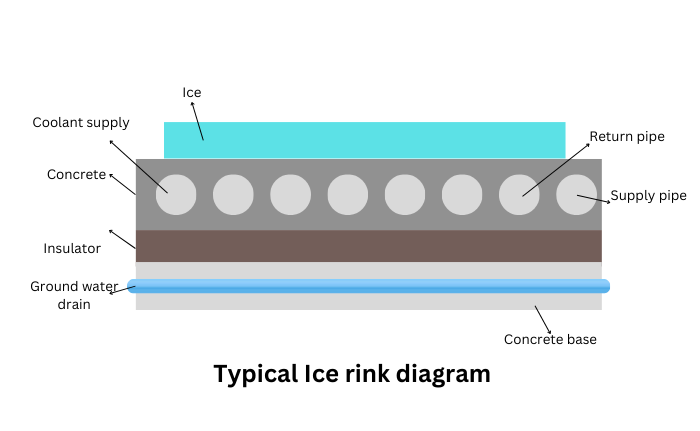
Ice rink project for Guangdong province
The Power of an 80-Ton Water-Cooled Chiller
Introduction:
Ice skating is a popular recreational activity enjoyed by people of all ages. In Guangdong province, China, the construction of an ice rink presented a unique challenge due to the region’s warm climate. To overcome this obstacle, an 80-ton water-cooled chiller from KAYDELI was employed to maintain a constant temperature of -8℃. This article explores the critical role of the chiller, the use of a glycol mixture as a coolant, and the essential components required to create a typical ice rink.
The Chiller: A Key Player in Ice Rink Construction
The 80-ton water-cooled chiller emerged as the hero of the ice rink construction project. With its impressive cooling capacity (183.1kW at -10℃), it ensured that the required temperature of -8℃ was consistently maintained. As per our client’s requirement, we chose the water-cooled type which is more efficient in terms of cooling and low maintenance. By utilizing advanced cooling technology, the chiller effectively counteracted the warm climate of Guangdong province, creating an ideal environment for ice skating enthusiasts.
The Glycol Mixture: A Reliable Coolant
To achieve the desired temperature, a glycol mixture was selected as the coolant for the ice rink. Glycol, a type of antifreeze, possesses excellent thermal properties and prevents freezing at subzero temperatures. By circulating the glycol mixture through the piping system, the chiller efficiently transferred heat away from the ice surface, keeping it frozen and safe for skating.
Piping System: Supplying Coolant for Optimal Cooling
A well-designed piping system played a crucial role in supplying the glycol mixture throughout the ice rink. This system ensured that the coolant reached every corner of the rink, maintaining a uniform temperature across the entire surface. By strategically placing the pipes beneath the ice, the heat was rapidly dissipated, allowing for efficient cooling and preventing any potential melting.
Building the Foundation: The Base for an Ice Rink
Creating a solid foundation is essential for constructing an ice rink that can withstand heavy usage and provide a smooth skating experience. The base for an ice rink typically consists of multiple layers, including insulation, piping, and a concrete or asphalt surface. The insulation layer prevents heat transfer from below, while the piping system distributes the coolant evenly. Finally, a durable concrete or asphalt surface provides stability and support for skaters.
Conclusion:
Constructing an ice rink in Guangdong province presented unique challenges due to its warm climate. However, by leveraging advanced cooling technology and utilizing an 80-ton water-cooled chiller, a successful ice rink was built with a consistent temperature of -8℃. The glycol mixture served as an efficient coolant, circulating through a well-designed piping system to maintain optimal cooling across the entire surface. With these essential components in place, ice skating enthusiasts can now enjoy their favorite activity in Guangdong province throughout the year.


